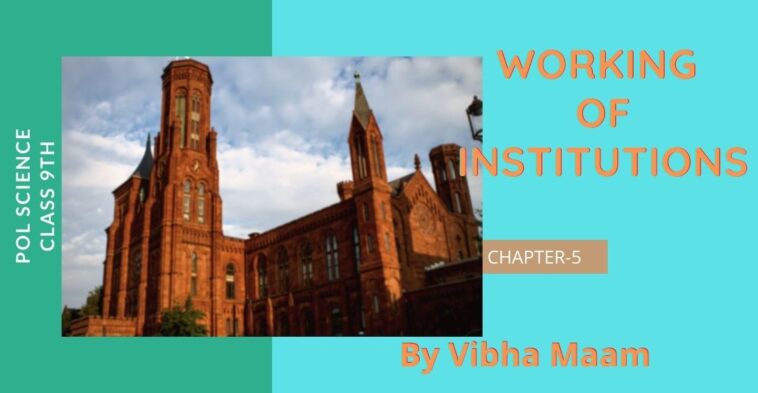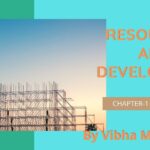Checkout handpicked notes of NCERT class 9th Pol Science Chapter 5 Working of Institutions notes by Vibha Maam and don’t forget to share your valuable comments in the comment below to motivate our author.
Working of Institutions notes by Vibha Maam
Office Memorandum
It is a government order, which looks like an ordinary circular or notice. it has a number and was signed by the joint secretary, (an officer in the Department of Personnel and Training in the Ministry of the Personnel Public Grievances and pensions), who signed the order.
The Decision Makers
Who decided to issue the memorandum?
The major functionaries are involved in decision making like the President, who is the head of the state and the highest authority in the country, Prime- minister who is the head of the Government and parliament which has two houses : Lok Sabha, and Rajya Sabha.
The Mandal Commission
- ‘The Second Backward Classes Commission‘ was called the Mandal commission, which was established in 1979. It was headed by BP Mandal. It was asked to determine the criteria to identify the socially and educationally backward classes in India and recommend steps to be taken for their advancement.
- This Commission gave its report in 1980 and made many recommendations. One of these was the 27% reservation in government jobs for the socially and economically backward classes (SEBC).
- The President of India of that time R. Venkataraman announced the intention of the government in parliament.
- On 6th August, 1990 the union cabinet took a formal decision to implement the recommendations.
- On 7 August, Prime minister VP Singh informed the parliament about this decision.
- The decision of the Cabinet was sent to the Department of Personnel and Training.
- An officer signed the order on behalf of the union government and this was how O.M. No.360 12/31/90 was born on August 13,1990.
- Many controversies arose, and people appealed to the Supreme Court to declare this order invalid and stop its implementation. This case was known as the ‘Indira Sawhney and others Vs union of India case‘.
- In 1992,the supreme court declared this order valid and asked the government to modify in its order
- To get benefits of reservation among the Other Backward Classes(OBC)
- Accordingly, the Department of Personnel and Training issued another Office Memorandum of September 8, 1993.
- The dispute, thus came to an end and this policy has been followed since then.
Need for Political Institutions
Democracy works well when Political institutions work properly. political institutions are the axis of any type of government. political institutions are required to take various decisions. Some important institutions working in India are the Prime minister and the cabinet ,the Civil servants, and the supreme court. Institutions are required to solve the disputes on any decision and implementation.
Framework of the Indian Government
Legislature, Executive, and Judiciary
The President of India
- The President of India is the chief executive.
- He or she is the constitutional head of India.
- He/she is also the first citizen of India.
Qualifications
- Must be citizen of India,
- Completed 35 years of age
- Member of Lok Sabha
- Not hold any government offices
Tenure:- 5 years
Vacancy:- Impeachment
Presidential Election
The president is elected indirectly. he is elected by the electoral college. the joint body of elected MPs and MLAs known as the electoral college.
Powers and Functions of the President
- The president is the administrative head of the country. all orders are issued in his name.
- The president is the supreme commander of the armed forces of India.
- The president appoints and dismisses the Prime minister.
- The president appoints the members of The Council of Ministers and distributes portfolios on the advice of the Prime minister.
- The president appoints the chief justice of the union judiciary and other judges on the advice of the chief justice.
- A bill can become a law only after the assent or sign of the president .
- The president summons both the houses of the parliament and prorogues them.
Impeachment
Impeachment is a procedure through which, president ,vice -president, and Chief justice of India can be removed from their post.
The Parliament
- Parliament is an assembly of elected representatives. At state level this is called the state legislative assembly.
- Parliament is the final authority for making laws in India. the annual budget or the money bills are passed by the parliament.
- Parliament has two houses – Lok Sabha and Rajya Sabha
Lok Sabha ( The Lower House)
Qualifications
- Must be an Indian
- Minimum age- 25 years
- Should not be holding any office of profit
Tenure – 5 years
Mode of Election – direct election
Nominations – two members of the Anglo Indian community
Strength – 552
(530 from States, 20 from Union Territories and two nominated by the President)
Presiding officer – Speaker (elected member from amongst its members)
Rajya Sabha (The Upper House)
Qualifications
- Must be citizen of India
- 30 years of age
- Not holding any office of profit
Tenure – 6 years ,one third of its members retire every two years , it is a permanent house
Mode of election – Indirect election
Nomination -12 members in the field of literature, science, art and social services
Strength – 245 (231 elected from states,2 from UT, 12 nominated)
Presiding officer – Chairman (vice president of India)
The Prime Minister of India
Qualifications:-
- Must be an Indian,
- Member of parliament
- Not be proclaimed offender
- Not holding any government offices
Tenure – 5 years
Vacancy– No-confidence motion, Resignation
Power and Functions of the Prime- Minister of India
- The Prime minister is the head of the government.
- The Prime minister selects the members of the Council of Ministers.
- The Prime minister is the chairperson of the planning commission.
- The Prime minister is a link between the president and the cabinet.
- The Prime minister represents India in international conferences like UN, SAARC,QUAD etc.
Powers and Functions of the Council of Ministers
- The cabinet formulates the government policies both National and international.
- The council of ministers administers his department in accordance with the policy decisions.
- The cabinet coordinates the working of all the departments.
- It introduces the money bills and the budget in the Lok Sabha
- The cabinet advises the President to summon the parliament to session
- There are three categories of ministers in the council of ministers:- Cabinet Ministers (top- level Ministers)
Ministers of State (Incharge of smaller Ministries)
Deputy Ministers (Assist the cabinet Ministers and ministers of State)
The Judiciary
Qualifications
- He or she must be a citizen of India.
- He or she must be at least five years a judge of high court or an advocate in high court for at least 10 years.
Tenure
- A judge can remain in office till he has attained the age of 65 years in the case of the supreme court and 62 years in case of the High court.
- He can be removed by the impeachment process.
Powers and functions of the Supreme Court
- The supreme court has original jurisdiction, it means that there are certain cases which can be directly heard by the supreme court.
- The supreme court has power to hear appeals; this is called the appellate jurisdiction.
- It is the guardian of our constitution and fundamental rights.
- It is also called the court records.
- The supreme court advises the president on any constitutional legal points.
Don’t forget to comment in the comment section below to appreciate and motivate our author by sharing this notes with your friends you can also Contact us for any query or if you are interested in writing with us.
Use Canva for amazing images.
Stay tuned for more amazing stories, poems & articles like this.
For sponsor any article or your article you can mail us with your logo ready and details.










thankyou mam for fabulous notes
Thank for your guidance mam